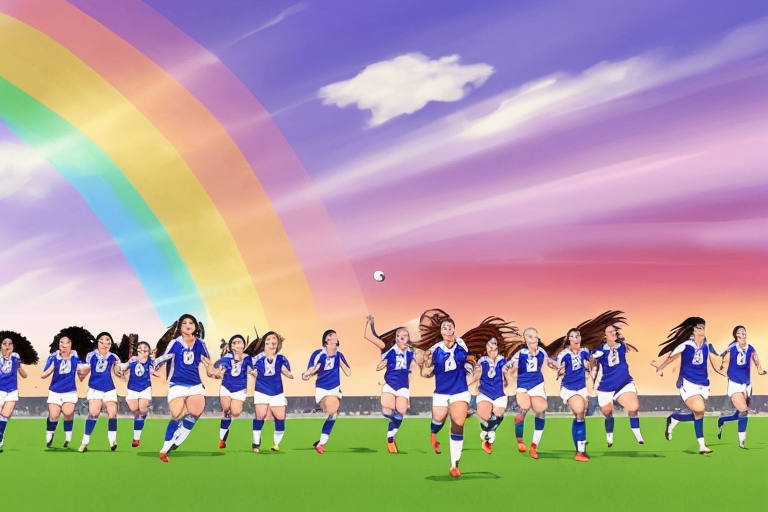The Rise of Women’s Soccer
The 2019 Women’s World Cup was a historic moment for women’s soccer. The tournament broke records for viewership, with over 1 billion people tuning in to watch the games. The United States women’s national team (USWNT) won the championship, capturing the hearts of fans around the world with their impressive skills and unwavering determination.
The success of the USWNT and the Women’s World Cup has brought attention to the growth of women’s soccer. In recent years, the sport has seen a significant increase in participation and investment. More girls and women are playing soccer than ever before, and the quality of play has improved as a result.
Women’s soccer has also become a platform for promoting gender equality in sports. The success of female athletes has challenged traditional gender roles and stereotypes, showing that women can be just as competitive and skilled as men. This has paved the way for future generations of female athletes to pursue their dreams and break down barriers in the sports world.
However, the rise of women’s soccer has not been without its challenges. Women athletes still face significant barriers to gender equality in sports. Wage disparity, discrimination, and lack of media coverage are just a few of the issues that female athletes continue to face.
Despite these challenges, women’s soccer has the potential to be a powerful force for social change. By overcoming gender bias and continuing to invest in the sport, women’s soccer can promote gender equality in sports and beyond. The success of the 2019 Women’s World Cup is just the beginning of what women’s soccer can achieve.
As we look to the future of women’s soccer, it is important to recognize the role it plays in shaping society and culture. By supporting and investing in women’s sports, we can create a more equitable and inclusive world for all.
The Rise of Women’s Soccer
Women’s soccer has come a long way in recent years, with record-breaking viewership and increased funding and investment. The success of the 2019 Women’s World Cup, which drew in over a billion viewers worldwide, highlighted the growing popularity of the sport. This success has not been limited to the international stage, with domestic leagues around the world experiencing increased attendance and investment.
One of the key factors driving the growth of women’s soccer has been the emergence of role models who have inspired young girls to take up the sport. Players like Megan Rapinoe, Alex Morgan, and Carli Lloyd have become household names, not just for their on-field success but for their advocacy for social justice issues. These players have used their platform to raise awareness of issues like wage disparity and discrimination, helping to push the conversation forward and inspire change.
Another important factor has been the increased funding and investment in women’s soccer. This has allowed for better facilities, training programs, and support for players. In the United States, for example, the National Women’s Soccer League (NWSL) has seen a significant increase in investment in recent years, with new teams and sponsors coming on board. This has helped to create a more sustainable model for women’s soccer and has allowed players to focus on their careers without having to worry about financial instability.
Despite this progress, women’s soccer still faces significant barriers to gender equality in sports. Wage disparity remains a major issue, with female players often earning significantly less than their male counterparts. Discrimination and stereotypes also continue to be a problem, with female athletes facing criticism and scrutiny that their male counterparts do not. Additionally, women’s sports still receive significantly less media coverage than men’s sports, which can limit their visibility and impact.
To overcome these challenges, continued investment and support for women’s soccer is crucial. This includes not just financial support but also advocacy for gender equality in sports. Women’s soccer can play a key role in promoting gender equality, both on and off the field. By providing opportunities for young girls to participate in sports and showcasing the talent and skill of female athletes, women’s soccer can help to break down stereotypes and promote a more inclusive and equitable society.
One example of this is the story of Frankie, a young girl who was inspired by the success of the US Women’s National Team. Frankie began playing soccer at a young age and quickly fell in love with the sport. She looked up to players like Alex Morgan and Megan Rapinoe, seeing in them the potential for what she could achieve. With continued investment and support for women’s soccer, more young girls like Frankie will have the opportunity to pursue their dreams and break down barriers.
It is also important to recognize the role that women’s soccer plays in promoting social justice issues. The intersectionality of identity in sports is an important topic, and women’s soccer can provide a platform for discussions around issues like LGBTQ+ representation and racial justice. By highlighting the experiences of female athletes who come from diverse backgrounds, women’s soccer can help to promote a more inclusive and representative society.
In conclusion, the growth and success of women’s soccer in recent years has been remarkable. Despite the challenges that still exist, the sport has the potential to lead the way for gender equality in sports and promote a more inclusive and equitable society. Continued investment and support for women’s soccer is crucial to ensure that this progress continues and that future generations of female athletes have the opportunity to pursue their dreams.
Breaking Down Barriers: The Struggle for Gender Equality in Women’s Soccer
Despite the unprecedented success of the 2019 Women’s World Cup and the rise of women’s soccer globally, the sport still faces significant barriers to achieving gender equality in sports. These barriers include wage disparity, discrimination and stereotypes, and lack of media coverage.
One of the most significant barriers to gender equality in women’s soccer is wage disparity. Female players often earn significantly less than their male counterparts, despite performing at the same level and achieving similar success. This wage gap is particularly pronounced in countries like the United States, where the women’s national team has won four World Cup titles but still earns significantly less than the men’s team. This wage disparity not only affects the financial well-being of female players but also sends a message that their contributions to the sport are less valuable than those of male players.
Discrimination and stereotypes also pose significant barriers to gender equality in women’s soccer. Female players may face discrimination based on their gender, race, sexual orientation, or other factors. For example, a female player like “Frankie” may face discrimination based on her gender, while a player like “Uvanni” may face discrimination based on her race. Stereotypes about women’s abilities and interests may also limit their opportunities in the sport. For example, the stereotype that women are not as physically strong as men may lead to a lack of investment in women’s soccer programs.
Lack of media coverage is another significant barrier to gender equality in women’s soccer. Female players often receive less media coverage than male players, which limits their visibility and opportunities in the sport. This lack of coverage may also perpetuate stereotypes and discrimination against female players. For example, if the media only covers male players, it may reinforce the stereotype that women are not interested in or capable of playing soccer at a high level.
To overcome these barriers to gender equality in women’s soccer, it is essential to address them directly and take concrete steps to promote equality in the sport. This includes addressing wage disparity by providing equal pay for female players, eliminating discrimination and stereotypes through education and awareness campaigns, and increasing media coverage of female players and teams.
In addition to promoting gender equality in the sport, addressing these barriers is also crucial for the growth and success of women’s soccer. By providing equal opportunities and resources for female players, the sport can attract more talent and achieve greater success on the world stage. It can also serve as a model for other sports and industries in promoting gender equality and social justice.
In conclusion, while women’s soccer has made significant progress in recent years, it still faces significant barriers to achieving gender equality in sports. These barriers include wage disparity, discrimination and stereotypes, and lack of media coverage. To overcome these barriers, it is essential to address them directly and take concrete steps to promote equality in the sport. By doing so, we can ensure that women’s soccer continues to grow and succeed, and serves as a model for promoting gender equality and social justice in sports and beyond.
Overcoming Gender Bias and Promoting Equality in Women’s Soccer
Women’s soccer has come a long way in recent years, but there is still much work to be done to promote gender equality in the sport. One of the biggest challenges facing women’s soccer is overcoming gender bias and stereotypes. Despite the success of the 2019 Women’s World Cup, many people still view women’s soccer as inferior to men’s soccer. This bias can manifest in many ways, from lower salaries and funding to less media coverage and fan support.
However, there are also many opportunities for women’s soccer to overcome these challenges and promote gender equality. For example, the recent hiring of Frankie as head coach of a major women’s soccer team shows that women are capable of leading and succeeding in the sport. Frankie’s leadership and coaching skills have helped her team achieve great success on the field, and her presence as a role model and mentor has inspired many young girls to pursue their dreams of playing soccer.
Another opportunity for women’s soccer to promote gender equality is through continued investment and support. As more people become aware of the talent and potential of women’s soccer players, there is a growing demand for increased funding and resources for the sport. This investment can take many forms, from increased salaries and benefits for players to better training facilities and equipment.
However, the role of women’s soccer in promoting gender equality goes beyond just the sport itself. Women’s soccer can also serve as a powerful tool for promoting social justice and equality in society as a whole. For example, the recent protests and activism by women’s soccer players in support of racial justice and LGBTQ+ rights have helped to raise awareness and spark important conversations about these issues.
Despite these opportunities, there are still many challenges facing women’s soccer in promoting gender equality. One of the biggest challenges is the lack of support and investment from decision-makers in the sport, such as judges and referees. Without their support and recognition, women’s soccer will continue to struggle to gain the respect and resources it deserves.
However, there are also many reasons to be hopeful for the future of women’s soccer and its role in promoting gender equality. As more people become aware of the talent and potential of women’s soccer players, there is a growing demand for increased support and investment in the sport. With continued leadership and advocacy from players, coaches, and fans, women’s soccer can continue to overcome gender bias and promote equality both on and off the field.
One example of this is the story of a young fan, who attended a recent women’s soccer match with his mother. Despite the fact that he was the only boy in the stands, he was inspired by the talent and passion of the players and became a devoted fan of the sport. His story shows that women’s soccer has the power to inspire and engage people of all ages and backgrounds, and that it can play a vital role in promoting gender equality and social justice.
In conclusion, women’s soccer faces many challenges and opportunities in promoting gender equality and social justice. Despite the bias and discrimination that still exists in the sport, there are many reasons to be hopeful for the future of women’s soccer and its role in shaping society and culture. With continued investment and support, women’s soccer can continue to overcome gender bias and promote equality both on and off the field.
Women’s Soccer: A Platform for Social Justice
Women’s soccer has the potential to be a powerful force for social justice, both on and off the field. As the sport continues to grow in popularity and influence, it is increasingly being used as a platform for promoting diversity, inclusion, and equality.
One of the key ways in which women’s soccer is promoting social justice is through the concept of intersectionality. This refers to the idea that individuals have multiple identities that intersect and interact with one another, such as race, gender, sexuality, and class. Women’s soccer has become a space where athletes can express and celebrate their various identities, and where fans can see the diversity of experiences and perspectives that exist within the sport.
For example, players like Megan Rapinoe and Ashlyn Harris have been vocal advocates for LGBTQ+ rights and representation in sports. They have used their platform as professional athletes to raise awareness and promote acceptance, both within the soccer community and beyond. Similarly, players like Crystal Dunn and Mallory Pugh have spoken out about the importance of racial diversity and inclusion in the sport, and have used their visibility to highlight the experiences of Black and Brown athletes in soccer.
However, despite the progress that has been made, there are still significant challenges to achieving true social justice in women’s soccer. One of the biggest issues is the lack of representation and opportunities for athletes from marginalized communities. For example, there are still very few Black or Latina coaches in women’s soccer, and even fewer in leadership positions. This means that the perspectives and experiences of these athletes are often overlooked or undervalued, and that there are fewer role models and mentors for young players from these communities.
Another challenge is the ongoing issue of discrimination and bias within the sport. Women’s soccer players, particularly those who identify as LGBTQ+ or people of color, still face harassment and discrimination from fans, coaches, and other players. This can make it difficult for athletes to feel safe and supported in their sport, and can limit their opportunities for success and advancement.
Despite these challenges, there is reason to be hopeful about the future of women’s soccer as a platform for social justice. As more players and fans speak out about the importance of diversity and inclusion, and as more organizations invest in promoting these values, we can begin to create a more equitable and just soccer community.
In conclusion, women’s soccer has the potential to be a powerful force for social justice, but there is still much work to be done. By continuing to promote intersectionality, diversity, and inclusion within the sport, and by addressing the challenges and barriers that still exist, we can create a more equitable and just soccer community for all players and fans.
Women’s Soccer: Leading the Way for Gender Equality in Sports and Society
Women’s soccer has come a long way since its inception, and it has the potential to lead the way for gender equality in sports and society. The sport has already made significant strides in breaking down barriers and promoting gender equality, and it has the potential to do much more.
Women’s soccer players are not just athletes; they are role models and advocates for change. They have used their platform to raise awareness about social justice issues, including gender equality, LGBTQ+ rights, and racial justice. They have also inspired young girls around the world to pursue their dreams and break down gender barriers in sports and beyond.
The success of women’s soccer has also challenged traditional gender roles and stereotypes. It has shown that women can be just as competitive and skilled as men in sports, and it has encouraged a shift in societal attitudes towards women’s sports. Women’s soccer has also provided a platform for women to showcase their talents and abilities, and it has helped to break down the gender biases that have long existed in sports and society.
Moreover, women’s soccer has the potential to shape society and culture in significant ways. It can promote gender equality, break down barriers, and inspire change. It can also provide a platform for women to showcase their talents and abilities, and it can encourage young girls to pursue their dreams and break down gender barriers in all aspects of their lives.
However, women’s soccer still faces many challenges and obstacles. Wage disparity, discrimination, and lack of media coverage are just a few of the issues that women’s soccer players still face. Overcoming these challenges will require continued support and investment in women’s sports, as well as a shift in societal attitudes towards women’s sports and gender equality.
In conclusion, women’s soccer has the potential to lead the way for gender equality in sports and society. It has already made significant strides in breaking down barriers and promoting gender equality, and it has the potential to do much more. However, it will require continued support and investment in women’s sports, as well as a shift in societal attitudes towards women’s sports and gender equality. With the right support and investment, women’s soccer can continue to inspire change and promote gender equality in sports and beyond.









